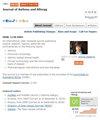Elevated Saliva Pepsin Concentration as a Risk Factor for Asthma in Children with Allergic Rhinitis: A Preliminary Study
IF 3
3区 医学
Q2 ALLERGY
引用次数: 0
Abstract
Objective: This study aimed to explore whether saliva pepsin concentration (SPC) could be regarded as a risk factor for the occurrence and unfavorable control of asthma in children with allergic rhinitis.Methods: A prospective study was conducted on a group of 20 consecutive children newly diagnosed with allergic rhinitis and asthma (referred to as the asthma group). All these children underwent fractional exhaled nitric oxide (FeNO) measurement, lung function tests, and assessment of asthma control using the 7-item Childhood Asthma Control Test (C-ACT) score. Simultaneously, a control group consisting of 20 children with simple allergic rhinitis, matched for baseline characteristics, was included. SPC measurement was performed in the two groups.
Results: The SPC value was significantly higher in the asthma group than that in the control group (165.0 ± 82.8 ng/mL vs 68.4 ± 34.5 ng/mL) (P < 0.001). In the asthma group, SPC was independently associated with FeNO, the ratio of forced expiratory volume in 1 second (FEV1) to forced vital capacity (FVC), and forced expiratory flow at 50% and 75% of FVC (FEF50 and FEF75) (all P < 0.05). The severity of nasal symptoms evaluated by the visual analogue scale (N-VAS) was independently associated with FEF75, the maximal mid-expiratory flow (MMEF), and C-ACT score (P < 0.05).
Conclusion: Direct pepsin exposure and uncontrolled nasal symptoms may play crucial roles in the pathogenesis and progression of childhood allergic asthma. The SPC value can be considered as a risk factor for asthma in children with allergic rhinitis.
Keywords: saliva pepsin concentration, asthma, allergic rhinitis, gastroesophageal reflux disease
唾液胃蛋白酶浓度升高是过敏性鼻炎患儿患哮喘的风险因素:初步研究
研究目的本研究旨在探讨唾液胃蛋白酶浓度(SPC)是否可被视为过敏性鼻炎患儿哮喘发生和控制不良的风险因素:这项前瞻性研究的对象是连续 20 名新诊断为过敏性鼻炎和哮喘的儿童(简称为哮喘组)。所有这些儿童都接受了部分呼出一氧化氮(FeNO)测量、肺功能测试,并使用 7 项儿童哮喘控制测试(C-ACT)评分对哮喘控制情况进行了评估。与此同时,该研究还纳入了由 20 名患有单纯过敏性鼻炎的儿童组成的对照组,两组儿童的基线特征相匹配。两组均进行了 SPC 测量:结果:哮喘组的 SPC 值明显高于对照组(165.0 ± 82.8 ng/mL vs 68.4 ± 34.5 ng/mL)(P < 0.001)。在哮喘组中,SPC 与 FeNO、1 秒钟用力呼气量(FEV1)与用力呼吸量(FVC)之比、50% 和 75% FVC 时的用力呼气流量(FEF50 和 FEF75)独立相关(均为 P <0.05)。用视觉模拟量表(N-VAS)评估的鼻部症状严重程度与 FEF75、最大呼气中流量(MMEF)和 C-ACT 评分独立相关(P < 0.05):结论:直接胃蛋白酶暴露和不受控制的鼻部症状可能在儿童过敏性哮喘的发病和发展过程中起着至关重要的作用。关键词:唾液胃蛋白酶浓度;哮喘;过敏性鼻炎;胃食管反流病
本文章由计算机程序翻译,如有差异,请以英文原文为准。
求助全文
约1分钟内获得全文
求助全文
来源期刊

Journal of Asthma and Allergy
Medicine-Immunology and Allergy
CiteScore
5.30
自引率
6.20%
发文量
185
审稿时长
16 weeks
期刊介绍:
An international, peer-reviewed journal publishing original research, reports, editorials and commentaries on the following topics: Asthma; Pulmonary physiology; Asthma related clinical health; Clinical immunology and the immunological basis of disease; Pharmacological interventions and new therapies.
Although the main focus of the journal will be to publish research and clinical results in humans, preclinical, animal and in vitro studies will be published where they shed light on disease processes and potential new therapies.
 求助内容:
求助内容: 应助结果提醒方式:
应助结果提醒方式:


